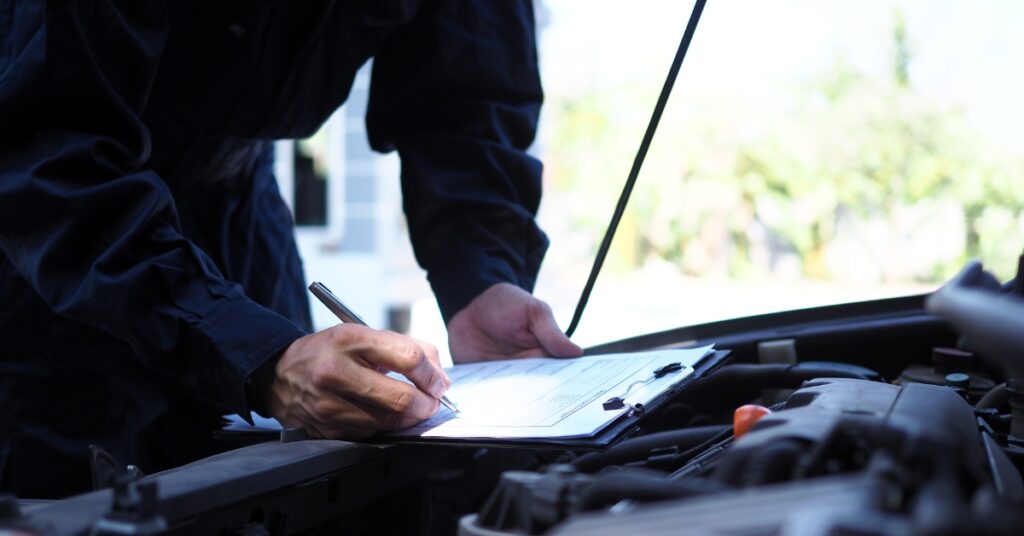
Table of Contents
When it comes to preventative car care, timing matters. Fall and spring are the two best times of year to schedule a seasonal multi-point inspection. After summer, your vehicle has endured months of heat, long road trips, and heavy A/C use. This all puts added strain on components like your battery, tires, and cooling system. An inspection in the fall helps address that wear while preparing your vehicle for shorter days, wetter roads, and more holiday driving.
Spring is another critical checkpoint. Even in Atlanta’s milder climate, winter brings its own stresses with fluctuating temperatures and increased use of heaters, wipers, and defrosters. Replacing worn wiper blades, topping off washer fluid, checking tire tread, and ensuring your cooling system is ready for warmer weather make spring inspections especially valuable. By scheduling inspections during these transitional seasons, you’re addressing issues right when they’re most likely to surface, saving yourself from costly surprises down the road.
What Is a Seasonal Multi-Point Inspection?
A seasonal multi-point inspection is a comprehensive checkup designed to assess your vehicle’s overall condition as the seasons change. Unlike single-service visits that address only one issue, like an oil change, this inspection looks at the entire vehicle. A trained technician examines critical systems, including the brakes, tires, fluids, suspension, belts, and electrical components. By reviewing everything at once, you get a complete picture of your car’s health and can plan repairs or replacements before they spiral into costly breakdowns.
Think of it as preventative healthcare for your car. Just like regular doctor visits can prevent expensive medical procedures down the road, seasonal inspections help you avoid high repair bills by addressing concerns early.
Why Schedule Inspections in Fall and Spring?
The timing of fall and spring inspections isn’t random – it’s strategic. These seasonal transitions are when your vehicle is most likely to show the effects of the weather, road conditions, and heavy use from the prior months.
In the fall, our team of ASE-certified technicians can check your battery, tires, and fluids to make sure they’ll hold up during colder, wetter months. Even though Atlanta winters are mild, batteries and tires still experience stress, and identifying wear early can prevent mid-season breakdowns.
In the spring, inspections focus on undoing the wear and tear of winter while preparing for warmer weather and summer driving. This is an ideal time to replace wiper blades, inspect the AC system, and rotate tires before long road trips. Seasonal checks at these intervals keep your car prepared and your budget protected.
The Benefits of Seasonal Multi-Point Inspections
Seasonal multi-point inspections do more than just identify wear and tear – they create long-term value for drivers. By catching small problems early and keeping your vehicle fine-tuned, these inspections deliver a wide range of benefits that protect your car, improve its performance, and save you money over time.
Protecting Your Vehicle’s Longevity
Every car part has a lifespan, and catching wear early ensures those parts are replaced before they damage connected systems. For example, a frayed belt can be replaced with a new one for a relatively low cost. If ignored, it may snap and cause thousands of dollars in engine damage. Inspections extend your vehicle’s life by maintaining harmony across all systems, saving you money by preventing premature replacement.
Improving Performance and Efficiency
Small issues like dirty air filters, low fluids, or uneven tire pressure might seem minor, but they quietly drag down your car’s efficiency. Seasonal inspections fine-tune these details, improving fuel economy and performance. Over time, fewer fill-ups and reduced strain on the engine add up to significant savings.
Reducing Long-Term Repair Costs
This is where the money-saving advantage really shines. A seasonal inspection might reveal a minor brake pad replacement before it wears down and damages the rotors, a fix that could be five times more expensive. Similarly, spotting a coolant leak early can prevent a blown head gasket repair that costs thousands. By addressing problems while they’re small, you keep repair bills manageable and predictable.
Enhancing Driver Confidence
Beyond dollars and cents, regular inspections mean you can drive without worrying about hidden issues. This peace of mind is invaluable, especially when you’re planning family trips or relying on your car for daily commutes. A reliable vehicle saves money indirectly, too, with fewer tows, missed workdays, or rideshare costs when your vehicle is in the shop.
What’s Included in a Seasonal Multi-Point Inspection?
Our multi-point inspection includes the following:
- Check and top off fluid levels
- Check all air filters and replace them as needed
- Battery strength inspection
- Inspection of headlights and other bulbs
- Check tires for uneven pressure and tread wear
- Inspect hoses, belts, wiper blades, and other key areas
Each of these checks might reveal small fixes today that prevent major, costly repairs tomorrow. That’s the whole value of seasonal multi-point inspections – they pay for themselves many times over.
Stay Ahead With Seasonal Car Care From McCullough NAPA
Car repairs are expensive, but many of them are avoidable. By committing to seasonal multi-point inspections in fall and spring, you’re not just protecting your vehicle – you’re protecting your wallet. Preventive maintenance lowers repair costs, extends the life of your car, and ensures every drive is dependable. If you want to save money and keep your vehicle in top shape, now’s the time to schedule your seasonal inspection.
Contact us to schedule your seasonal multi-point inspection today!
